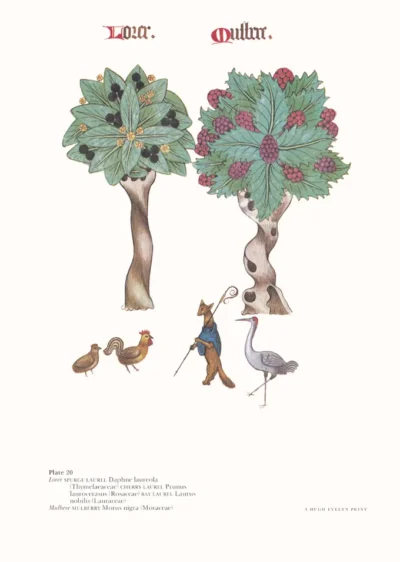Laurel & Mulberry
£20.00
Laurel and Mulberry (scroll down for a more detailed Description)
Published 1972 by © Hugh Evelyn Limited; drawn around 1525, these images were finished in gouache and watercolour (see description here)
Size: c. 23 x 33.5 cm [9 ″ x 13 ¼ ″] may vary slightly from printers’ cut 50 years ago
Printed on high white matt cardstock 144 g/sm2.
Print is STANDARD size – shipping is the same for 1 to 10 prints (based on largest print size in your order) – see Shipping & Returns.
In stock
Description
Laurel: Prunus laurocerasus, also known as cherry laurel, common laurel and sometimes English laurel in North America, is an evergreen species of cherry (Prunus), native to regions bordering the Black Sea in southwestern Asia and southeastern Europe, from Albania and Bulgaria east through Turkey to the Caucasus Mountains and northern Iran. Laurus nobilis is an aromatic evergreen tree or large shrub with green, glabrous leaves, in the flowering plant family Lauraceae. It is native to the Mediterranean and is used as bay leaf for seasoning in cooking. Its common names include bay laurel, sweet bay, bay in the United Kingdom. These both have small flowers, black berries and glossy leaves. The Cherry Laurel, an introduction, is self-sown and naturalised and scattered over the British Isles. Their black fruits are wholesome and good to eat, but the leaves contain amygdalin from which the poisonous hydrocyanic acid (prussic acid) is formed on bruising or chewing. They were used by entomologists in ‘killing bottles’, and in Cherry Laurel water, a sedative of value in treating coughs and asthma, dyspepsia and indigestion. Gerard (1) called this species the Cherry Bay which suggests another laurel, Sweet Bay, Laurus nobilis, a native of the Mediterranean, used for crowns and garlands, since it was sacred to Apollo, a symbol of victory. This has creamy flowers and purple fruits which never form in our climate. Once used medicinally it is now used in cookery, to give flavour to custards, milk puddings, soups and stews. Milberry: Morus, a genus of flowering plants in the family Moraceae, comprises 10 – 16 species of deciduous trees commonly known as mulberries, growing wild and under cultivation in many temperate world regions. The Mulberry tree commonly grown in this country is Morus nigra, a native of Persia, which has long been cultivated for its fruits. It was established in England before Shakespeare’s time, and James I planted many of these trees to establish a silk-worm industry. Although silk-worms (caterpillars of the silk moth, Bombyx mori) will feed on their leaves, they originally fed on the leaves of Morus alba, a related species found in their own native China. The juicy purple-black fruits can be eaten, cooked to make jam or tarts, or used to make wine and can be used to make Mulberry gin, in the same way as Sloe gin. The Anglo-Saxons made a drink called morat from Mulberries flavoured with honey. The Mulberry juice is useful when convalescing from fever as it checks the thirst and cools the blood. The bark can be used as a purgative, and against worms. According to the 12th century Book of Beasts (2) ‘mulberry leaves kill snakes, if thrown over them.’ Arber (3) reproduces a woodcut of a Mulberry from Mattioli (4), dating from 1562, and comments that it would need little modification to form the basis of a tapestry pattern.
Additional information
| Weight | 0.0094 kg |
|---|---|
| Dimensions | 24 × 33.7 cm |

 Great Northern Railway, 1898
Great Northern Railway, 1898  Ash & Almond
Ash & Almond 



